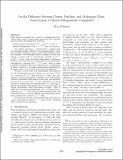| dc.contributor.author | Williams, Ryan | |
| dc.date.accessioned | 2021-11-03T18:42:38Z | |
| dc.date.available | 2021-11-03T18:42:38Z | |
| dc.date.issued | 2018-01 | |
| dc.identifier.uri | https://hdl.handle.net/1721.1/137304 | |
| dc.description.abstract | © Copyright 2018 by SIAM. Point location problems for n points in d-dimensional Euclidean space (and 'p spaces more generally) have typically had two kinds of running-time solutions: (Nearly-Linear) less than dpoly(d) n logO(d) n time, or (Barely-Subquadratic) f(d)n2-1= (d) time, for various f. For small d and large n, \nearly-linear" running times are generally feasible, while the \barely-subquadratic" times are generally infeasible, requiring essentially quadratic time. For example, in the Euclidean metric, finding a Closest Pair among n points in Rd is nearly-linear, solvable in 2O(d) n logO(1) n time, while the known algorithms for finding a Furthest Pair (the diameter of the point set) are only barelysubquadratic, requiring (n2-1=(d)) time. Why do these proximity problems have such different time complexities? Is there a barrier to obtaining nearly-linear algorithms for problems which are currently only barely-subquadratic? We give a novel exact and deterministic self-reduction for the Orthogonal Vectors problem on n vectors in f0; 1gd to n vectors in Z!(log d) that runs in 2o(d) time. As a consequence, barely-subquadratic problems such as Euclidean diameter, Euclidean bichromatic closest pair, and incidence detection do not have O(n2-1) time algorithms (in Turing models of computation) for dimensionality d = (log log n)2, unless the popular Orthogonal Vectors Conjecture and the Strong Exponential Time Hypothesis are false. That is, while the poly-log-log-dimensional case of Closest Pair is solvable in n1+o(1) time, the poly-log-log-dimensional case of Furthest Pair can encode difficult large-dimensional problems conjectured to require n2-o(1) time. We also show that the All-Nearest Neighbors problem in !(log n) dimensions requires n2-o(1) time to solve, assuming either of the above conjectures. | en_US |
| dc.language.iso | en | |
| dc.publisher | Society for Industrial and Applied Mathematics | en_US |
| dc.relation.isversionof | 10.1137/1.9781611975031.78 | en_US |
| dc.rights | Article is made available in accordance with the publisher's policy and may be subject to US copyright law. Please refer to the publisher's site for terms of use. | en_US |
| dc.source | SIAM | en_US |
| dc.title | On the Difference Between Closest, Furthest, and Orthogonal Pairs: Nearly-Linear vs Barely-Subquadratic Complexity | en_US |
| dc.type | Article | en_US |
| dc.identifier.citation | Williams, Ryan. 2018. "On the Difference Between Closest, Furthest, and Orthogonal Pairs: Nearly-Linear vs Barely-Subquadratic Complexity." Proceedings of the Annual ACM-SIAM Symposium on Discrete Algorithms. | |
| dc.contributor.department | Massachusetts Institute of Technology. Department of Electrical Engineering and Computer Science | |
| dc.contributor.department | Massachusetts Institute of Technology. Computer Science and Artificial Intelligence Laboratory | |
| dc.relation.journal | Proceedings of the Annual ACM-SIAM Symposium on Discrete Algorithms | en_US |
| dc.eprint.version | Final published version | en_US |
| dc.type.uri | http://purl.org/eprint/type/ConferencePaper | en_US |
| eprint.status | http://purl.org/eprint/status/NonPeerReviewed | en_US |
| dc.date.updated | 2021-03-30T14:28:03Z | |
| dspace.orderedauthors | Williams, R | en_US |
| dspace.date.submission | 2021-03-30T14:28:04Z | |
| mit.license | PUBLISHER_POLICY | |
| mit.metadata.status | Authority Work and Publication Information Needed | en_US |
